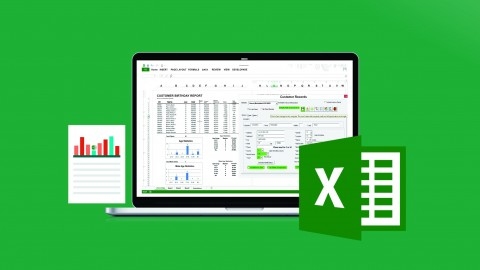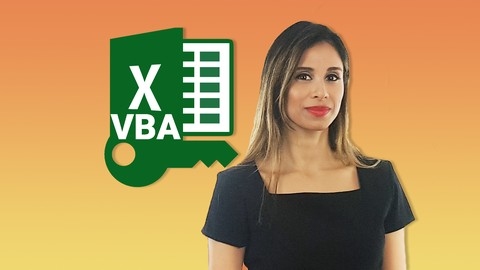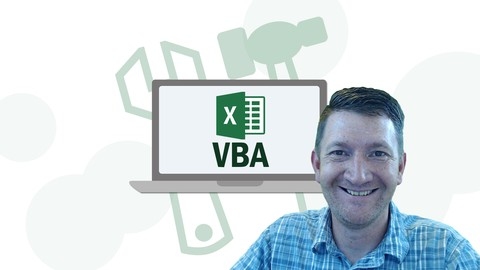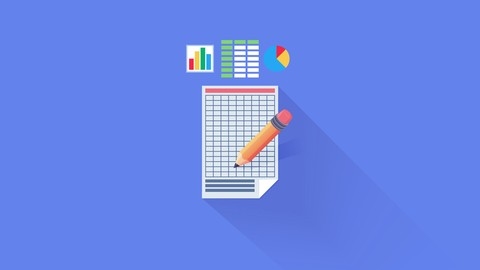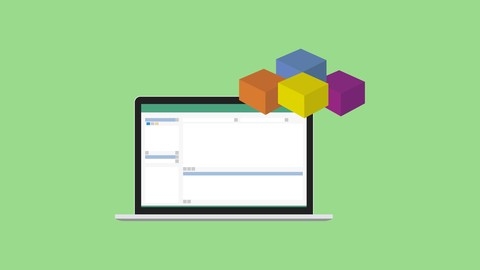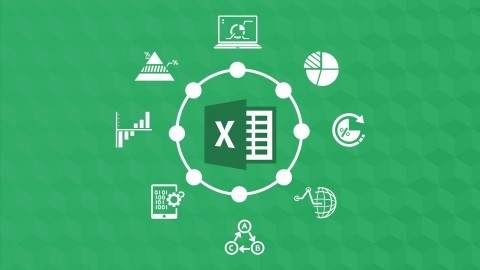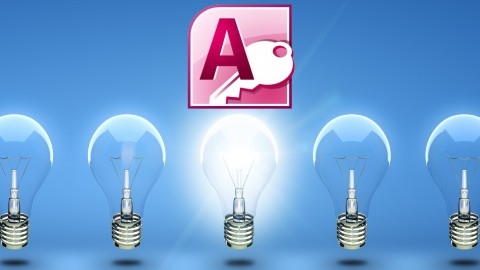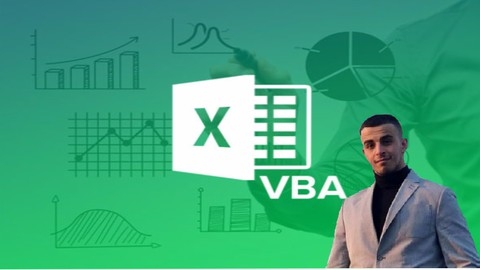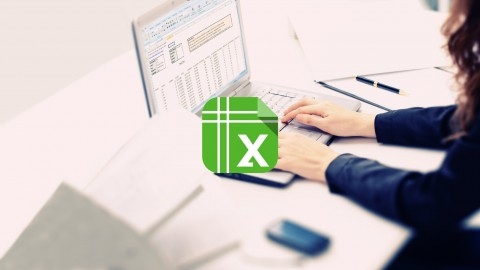VBA, or Visual Basic for Applications, is a powerful programming language built into Microsoft Office applications, including Excel.
By learning VBA, you can automate repetitive tasks, build custom tools, and significantly enhance your productivity within Excel.
This allows you to analyze data, create reports, and manage workflows more efficiently.
Finding a good VBA course on Udemy can feel overwhelming, with so many options claiming to be the best.
You’re searching for a course that is comprehensive, engaging, and taught by a knowledgeable instructor, but also one that aligns with your learning style and pace.
We’ve carefully reviewed dozens of Udemy courses and recommend Unlock Excel VBA and Excel Macros as the best course overall.
This course stands out for its structured approach, covering everything from basic macro recording to advanced VBA programming concepts, making it perfect for beginners and experienced users alike.
It includes numerous practical examples and real-world projects, ensuring that you can apply what you learn to your own work.
This is just one great option for learning VBA on Udemy.
If you’re looking for a more specialized course focused on specific VBA features or applications, we have plenty of other excellent choices to explore.
Keep reading to discover more recommendations, tailored to your specific needs and goals.
Unlock Excel VBA and Excel Macros
The course starts by introducing you to macros and the Visual Basic Editor (VBE).
You’ll record your first macro and understand the difference between macros and VBA.
As you progress, you’ll dive deep into the VBA object model, which is crucial for writing correct syntax and avoiding errors.
You’ll learn how to reference ranges, worksheets, and workbooks effectively using VBA.
Working with variables and understanding data types will help you write efficient code.
The course covers looping through collections, making decisions with conditions like If-Then statements, and using built-in functions like InputBox and MessageBox.
Debugging techniques, error handling, and procedure scope are covered to help you troubleshoot and optimize your code.
You’ll then apply your skills to create a tool that automatically generates a table of contents for any Excel workbook.
The course explores advanced topics like looping, arrays (including dynamic arrays), working with files and folders, interacting with other Office applications like Word and PowerPoint, and using events like worksheet selection change.
You’ll build practical tools, such as a regional sales reporting tool that imports data from multiple files, generates reports, and exports them as Excel files or PDFs.
User forms and ActiveX controls are introduced, allowing you to create interactive data entry forms and enhance your tools’ functionality.
You’ll even learn to create custom functions in VBA.
Throughout the course, you’ll work on projects like an invoice generation tool that uses user forms, creates PDFs, and sends emails with attachments using Outlook.
The course concludes by covering charts in VBA, enabling you to create and modify charts programmatically.
Master Microsoft Excel Macros and Excel VBA
You’ll start by learning the basics of recording simple macros with Excel’s built-in Macro Recorder tool.
In the first project, you’ll create a macro that inserts and formats text on a worksheet, introducing you to the recorder’s capabilities.
You’ll also learn how to run macros and assign them to buttons or shortcuts.
As you progress, the course dives into Visual Basic for Applications (VBA), Excel’s powerful programming language.
You’ll explore the VBA development environment (VBE) and learn core concepts like variables, loops, and conditional logic.
Project 2 teaches you to enhance recorded macros with VBA code, making them interactive by prompting users for input.
Project 3 combines the macro recorder with VBA to create reusable macros that can clean up and format data across multiple worksheets.
You’ll also learn best practices for using the recorder effectively.
In Project 4, you’ll automate Excel’s SUM function using VBA, summing up data ranges across worksheets.
This project introduces you to looping through worksheets programmatically.
The course culminates in Project 5, where you’ll bring together all the skills learned to create a weekly report generator.
This macro will copy and paste data from multiple worksheets into a new report, showcasing your mastery of VBA.
Additionally, Project 6 covers creating user interfaces with VBA forms, allowing you to build interactive tools within Excel.
You’ll also learn to import data from external text files in Project 7, expanding Excel’s capabilities.
Throughout the course, you’ll complete quizzes and hands-on exercises to reinforce your understanding.
The Ultimate Excel Programmer Course
Right from the start, you’ll learn the fundamentals of the Range object and how to write macros from scratch.
The instructor walks you through adding commands, debugging line-by-line, and testing values - essential skills for any VBA developer.
The course dives deep into using variables, performing math operations, string manipulation, and working with dates and times.
You’ll master techniques like concatenation, finding substrings, and formatting values.
These allow you to create dynamic and powerful macros.
A major focus is Excel logic and control flow using If…Then statements, loops, and user input with InputBoxes.
You’ll build practical projects like a random password generator, a name definition game, and even a fun Rock Paper Scissors game!
This hands-on approach reinforces the concepts wonderfully.
Events are covered extensively - you’ll learn to trigger macros based on worksheet changes, selections, right-clicks, and more.
This allows you to create smart, reactive spreadsheets.
You’ll even customize the right-click context menu!
The course teaches you to supercharge your spreadsheets with controls like buttons, textboxes, comboboxes, and listboxes.
These enable intuitive user interfaces and data entry forms right within Excel.
You’ll master properties, events, and techniques like dynamic filtering for these controls.
Userforms are a game-changer, allowing you to build professional-grade data entry tools and reports.
Step-by-step, you’ll create an interactive employee database with edit mode, search, photo uploads, and more.
Reports get the royal treatment too - custom sorting, filters, formatting like zebra-striped rows, and even printing!
Throughout, you’ll pick up pro tips for speeding up code, best practices, and workflow efficiency hacks.
Excel VBA programming by Examples (MS Excel 2016)
You will start by learning how to automate tasks without coding by recording macros.
This includes understanding macros, creating shortcuts, running macros on new datasets, and recording relative macros.
Next, you’ll dive into the VBA development environment and syntax.
You’ll learn how to define variables, write loops, display outputs, take user inputs, use breakpoints, and run macros from buttons.
The course covers conditional statements like if-else and do-while loops.
The core of the course consists of several workout examples that build your VBA skills step-by-step.
You’ll design forms with controls like dropdowns, listboxes, and buttons to create user-friendly interfaces.
You’ll fetch data from Microsoft Access databases, generate worksheets based on criteria, manage inventory and coupons, and write data to text files.
Other examples cover using VBA with pivot tables, VLOOKUP, sorting, Windows authentication, voice notifications, SQL queries within VBA, scheduling macros, calculating recursive file sizes, and combining multiple files.
You’ll also learn to store form data in Access databases.
The course emphasizes practical applications, ensuring you understand when and how to use different VBA features.
You’ll work with formatting, derived information, error handling, and protecting your Excel tools.
The examples are designed to be engaging and relevant, helping you build a solid foundation in Excel VBA programming.
Excel VBA Programming - The Complete Guide
You’ll start by setting up the VBA development environment, configuring security settings, and exploring the built-in macro recorder.
Next, you’ll dive into the fundamentals of the Excel Object Model, which is the backbone of VBA programming.
You’ll learn about object-oriented programming principles, write your first procedures, and output content to the Excel interface.
The course then guides you through the Visual Basic Editor (VBE), where you’ll learn to create and delete procedures, work with the Immediate Window, and use the MsgBox method to display messages.
As you progress, you’ll explore objects and methods available in the Excel Object Model, such as the Application, Workbooks, Worksheets, and Range objects.
You’ll learn how to invoke methods with various arguments and access the Object Browser to read documentation.
The course covers essential programming concepts like variables, data types (including Longs, Doubles, Strings, Booleans, and Dates), and arrays.
You’ll learn how to declare variables, perform mathematical operations, and work with dynamic arrays.
Moving forward, you’ll master the syntax for declaring procedures, understand variable scope, and learn about predefined constants (enumerations).
You’ll also explore conditional statements (If, ElseIf, Select Case) and logical operators (AND, OR, NOT).
Iteration is a crucial aspect of programming, and you’ll learn about For and For Each loops, the Step keyword, and how to exit loops prematurely.
The course dives deep into working with ranges, covering topics like R1C1 notation, the Offset and Resize properties, the Cells property, and various range actions like FillDown, Replace, and Sort.
You’ll also learn about error handling techniques, stepping through code, and setting breakpoints for debugging purposes.
Additionally, the course covers events, which are Excel actions that can automatically trigger VBA procedures.
You’ll learn about events like Worksheet_SelectionChange, Worksheet_Change, and Workbook_Open, and how to react to them.
User Forms are a powerful feature in VBA, and you’ll learn how to create custom forms with labels, textboxes, buttons, and other controls.
You’ll also learn about naming conventions, design aesthetics, and how to wire up event procedures to handle user interactions.
Finally, the course explores VBA functions, including string manipulation, date and time functions, and even custom functions that appear directly in the Excel interface.
Throughout the course, you’ll work with practical examples and exercises, ensuring that you not only understand the concepts but also gain hands-on experience in applying them.
Ultimate Excel VBA
You will start by learning the basics of the macro recorder and the VBA editor, before diving deep into the Excel object library.
This will teach you how to reference and manipulate various Excel objects like worksheets, workbooks, and ranges using their properties and methods.
The course then covers the fundamentals of the VBA language itself.
You’ll learn about variables, data types, input/output, conditional statements like IF…THEN and SELECT CASE for branching logic, and looping constructs like FOR…NEXT and DO…LOOP.
It also touches on important concepts like variable scope, error handling, and creating user-defined functions.
But the real power comes from combining your VBA skills with the ability to launch macros in response to user actions and system events.
You’ll learn how to attach macros to worksheet objects, the ribbon, and hook into workbook, worksheet, and application events to run code automatically.
To enhance the user experience, the course teaches you to modify the Excel interface using message boxes, ActiveX controls on worksheets (with and without code), and custom user forms.
You’ll even get to create interactive forms by coding interactions between ActiveX controls.
The course culminates with a glimpse into cross-application programming by using VBA to control Word from within Excel.
Throughout, you’ll work on short projects that reinforce the concepts learned in each section.
Microsoft Access VBA for Non Programmers - YOU Can Do This!
This course is an excellent resource for learning Microsoft Access VBA, even if you have no prior programming experience.
You will start by creating and debugging simple VBA subroutines, learning how to handle errors, and taking control of the keyboard.
As you progress, you’ll build subroutines to sort records, implement instant search functionality using recordsets and variables, and pass data between forms.
The course covers advanced topics like creating interactive pulldown filters, building reports with complex calculations, modifying table structures within VBA, and working with subforms.
You’ll also learn how to turn off the menu, ribbon, and navigation pane, create popup forms that pause your program until closed, and tackle classic programming challenges like performing recalculations on every record in a table using double loops and SQL queries.
Throughout the course, you’ll gain hands-on experience writing VBA code, debugging programs, and implementing practical solutions for common database tasks.
The lectures are structured in a way that builds your skills incrementally, with quizzes and reviews to reinforce your learning.
By the end, you’ll be well-equipped to create sophisticated VBA applications in Microsoft Access.
Master all the MS Excel Macros and the basics of Excel VBA
The course starts by covering the basics, introducing you to Excel VBA and object-oriented programming concepts.
You’ll learn how to understand and work with Excel from a developer’s perspective.
Once you have a solid foundation, the course dives into macro creation.
Over six comprehensive lectures, you’ll gain a deep understanding of macros, from the fundamentals to advanced techniques.
This section is crucial for automating repetitive tasks and streamlining your workflow.
The course then transitions to VBA programming, dedicating six lectures to this powerful language.
You’ll learn how to write VBA code, leverage its capabilities, and integrate it with Excel to create powerful solutions.
The course also covers details, exploring advanced topics and techniques to take your skills to the next level.
You’ll gain insights into best practices, optimization strategies, and troubleshooting methods.
Throughout the course, you’ll have access to hands-on exercises and real-world examples, ensuring you can apply what you’ve learned to practical scenarios.
The course is designed to be comprehensive, covering everything from the basics to advanced VBA concepts, making it suitable for beginners and experienced users alike.
With its structured approach and in-depth coverage of VBA and macros, this course equips you with the skills to automate tasks, enhance productivity, and unlock the full potential of Excel.
Excel VBA: How to Write Macros Like a Professional
The course starts by setting you up for success, providing strategies to get the most out of the material, like assigning dedicated time each day and practicing writing code.
You’ll learn how to create and run your first macro, work with modules, and utilize the Immediate Window for testing.
A significant portion of the course focuses on working with workbooks, worksheets, and ranges.
You’ll learn different techniques to access and manipulate cells, format ranges, and write flexible code using offsets.
There’s even a mini-project where you’ll apply these skills to a real-world scenario.
Debugging is crucial when writing macros, and this course dedicates an entire chapter to it.
You’ll learn how to step through code, use breakpoints, and monitor variables with the Locals and Watch windows.
The course covers essential programming concepts like conditions (if statements), loops (for, for each, do), and handling errors.
You’ll also learn how to open workbooks, use functions and subs, run macros with shortcuts or buttons, and work with arrays.
One standout section is on copying and filtering data, where you’ll explore three different VBA methods (for loop, AutoFilter, and Advanced Filter) and understand the pros and cons of each approach.
Throughout the course, you’ll find downloadable resources like cheat sheets, sample code, and supporting text to reinforce your learning.
The course strikes a good balance between theory and practical examples, ensuring you gain hands-on experience with writing macros.
Excel with Microsoft Excel VBA User Forms
This course will teach you how to build user interfaces with Excel VBA UserForms and connect them to worksheets for data entry.
You’ll start by creating a UserForm with various controls like text boxes, combo boxes, and buttons.
Then, you’ll learn how to set the properties of these controls and add code to handle their events.
Next, you’ll connect the UserForm to a worksheet, allowing users to enter data through the form and have it transferred to the worksheet.
You’ll also learn how to validate data entry, generate unique record IDs, and perform calculations using VBA.
The course will then guide you through creating a print report by looping through worksheets, pasting data into a new workbook, and adding cleanup code.
You’ll even learn how to build a UserForm to display current call stats by creating a temporary worksheet and calculating statistics with VBA.
Finally, you’ll explore how to email these stats using VBA and Outlook.
Throughout the course, you’ll complete exercises and quizzes to reinforce your learning.
